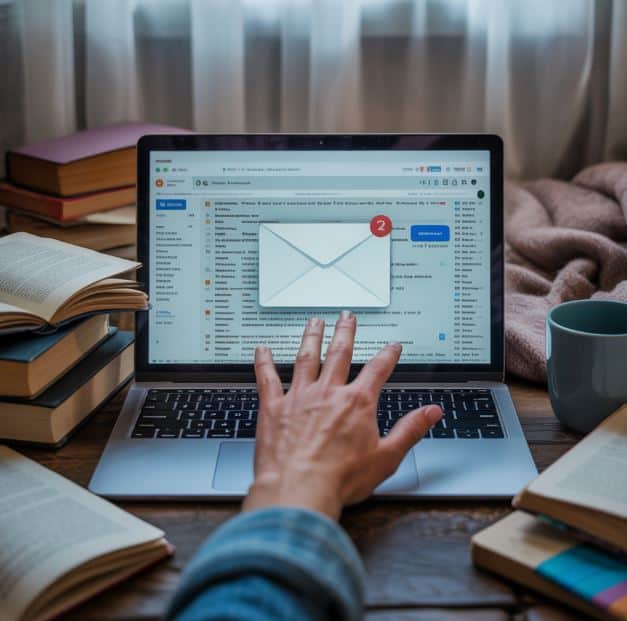How to Overcome Inbox Avoidance When Email Anxiety Takes Over
You just spent twenty minutes reorganizing your desktop files instead of checking email, not for the first time.
Your phone shows 847 unread messages, but you’d rather clean out your junk drawer than open that app. Every time you think about your inbox, your shoulders tense up like you’re bracing for impact.
Here’s what nobody talks about: inbox avoidance isn’t laziness. It’s actually your brain treating email like a genuine threat. When you see hundreds of unread messages, your nervous system responds the same way it would to a room full of angry people demanding your attention.
And your avoidance makes perfect sense once you understand what’s really happening in your head.
Why Your Brain Treats Email Like Danger
 Your inbox triggers the same fight-or-flight response as physical threats. Every unread message represents a potential demand, decision, or social interaction you’ll need to manage. Your brain doesn’t distinguish between a charging bear and 200 work emails – both feel overwhelming.
Your inbox triggers the same fight-or-flight response as physical threats. Every unread message represents a potential demand, decision, or social interaction you’ll need to manage. Your brain doesn’t distinguish between a charging bear and 200 work emails – both feel overwhelming.
Have you noticed your breathing getting shallow every time you open your email? Like your body is preparing for battle against… digital messages. It sounds ridiculous until you realize that your nervous system evolved for physical threats, not information overload.
When you can’t fight or flee from your inbox, your stress response gets stuck. You end up carrying around this low-level anxiety all day, like background music you can’t turn off.
The Always-On Trap
Smartphones made this worse by putting your entire office in your pocket. So now you can feel guilty about unanswered emails while brushing your teeth, watching Netflix, or trying to fall asleep.
You used to leave work at work but now work follows you everywhere through that little red notification badge. Your brain never gets a break from email stress because there’s always another message waiting.
What Inbox Avoidance Actually Looks Like
You wake up planning to tackle your unread emails after coffee. But breakfast comes and goes, so does lunch. You’ve successfully avoided your inbox for six hours but spent those same six hours thinking about it.
You finally check your phone and scan through messages quickly. You respond to the urgent ones and mark everything else as read without actually reading it. Or you read them but don’t respond, promising yourself you’ll deal with it tomorrow.
Tomorrow never comes and the unread count keeps climbing and the anxiety keeps building.
The Physical Response You Can’t Ignore
Your body keeps score even when your mind tries to rationalize. You might notice your jaw clenching when you see email notifications and your breathing might get shallow when you think about that message from your boss you haven’t answered yet.
These aren’t dramatic overreactions. They’re normal responses to chronic stress. Your nervous system is trying to protect you from what it perceives as an overwhelming threat.
Why Email Became Everyone Else’s To-Do List
Email wasn’t supposed to be this stressful. It was supposed to make communication easier but it has became a 24/7 obligation machine where other people can assign you tasks without asking permission.
Think about it: every message in your inbox represents work someone else put on your desk. They decided you needed to read their thoughts, respond to their questions, or take action on their priorities. Your inbox became their way of managing their to-do list.
Research from McKinsey shows the average knowledge worker spends 28% of their workweek managing email. That’s more than a full day every week just moving digital messages around. Most of that time isn’t even spent on important communication – it’s spent feeling anxious about messages you’re not responding to.
The Expectation Trap
No email is innocent, it comes with invisible expectations. The sender expects a response, usually quickly. They expect you to remember previous conversations, understand context that might be missing, and care about their timeline.
When you have 200 unread emails, you’re carrying 200 sets of unmet expectations and your brain interprets this as 200 ways you’re failing people. No wonder checking email feels like walking into a courtroom where you’re definitely guilty.
To explore the psychology of email anxiety and ways to manage digital overwhelm, check out this thorough piece from the Harvard Business Review: Why Your Brain Struggles with Email.
The Hidden Psychology Behind Email Anxiety
Inbox avoidance isn’t really about email. It’s about control, overwhelm, and the impossible task of managing everyone else’s expectations while trying to do your actual work.
Context Switching Nightmare
 Every email forces your brain to switch contexts. In one scroll through your inbox, you might jump from a work deadline to a family event invitation to a bill reminder to a newsletter about productivity tips.
Every email forces your brain to switch contexts. In one scroll through your inbox, you might jump from a work deadline to a family event invitation to a bill reminder to a newsletter about productivity tips.
Dr. Sophie Leroy’s research on “attention residue” shows that when you switch between tasks, part of your mental energy stays stuck on the previous task. Email forces constant context switching, leaving you feeling scattered and exhausted even when you haven’t accomplished anything meaningful.
The Perfect Response Trap
You avoid responding because you want to craft the perfect reply. You read a message and think, “I need to give this proper attention when I have more time.” But you never have more time, so the email sits there for weeks, generating more anxiety.
How to Break the Inbox Avoidance Cycle
The solution isn’t better email organization, it’s changing your relationship with email entirely. You need strategies that address the underlying anxiety, not just the symptoms.
Email Bankruptcy Is Okay
 If you have more than 100 unread emails older than two weeks, you need to hear this: you’re never going to catch up by processing them one by one. You need to declare email bankruptcy.
If you have more than 100 unread emails older than two weeks, you need to hear this: you’re never going to catch up by processing them one by one. You need to declare email bankruptcy.
Create a folder called “Archive 2025” and move everything older than one week into it, don’t delete it – just get it out of your main inbox. If something was truly important, the sender will follow up.
This feels scary because we’re taught that being responsible means responding to everything. But what’s actually irresponsible is spending weeks paralyzed by email anxiety instead of focusing on current priorities.
The Two-Minute Reality Check
Here’s how to actually use the two-minute rule: if an email will take more than two minutes to handle properly, don’t open it unless you have time to deal with it right then.
Stop doing those anxiety-inducing preview scans where you read just enough to stress yourself out but not enough to actually respond. Either fully process an email or don’t open it at all.
Batch Processing for Your Sanity
Pick specific times to check email instead of keeping it open all day. Maybe process your inbox at 9 AM, 1 PM, and 4 PM. Outside those times, email is closed.
This eliminates the constant mental interruption of new messages arriving. Your brain can focus on actual work instead of managing the stream of digital requests.
Healthier alternative: Try the “touch it once” rule – when you open an email, either respond immediately, schedule time to respond later, delete it, or file it. Don’t read it and leave it floating in your mental queue.
Setting Boundaries That Actually Protect You
The real solution to inbox avoidance isn’t better email habits – it’s better boundaries. You have to decide what level of availability works for your life and communicate that clearly.
Response Time Reality
Add a line to your email signature about response times: “I check email three times daily and respond within 24 hours. For urgent matters, please call.”
This simple addition eliminates guilt about not being instantly available. People know when to expect responses, and you stop feeling like you’re failing when you don’t reply immediately.
The Great Unsubscribe
Spend one hour unsubscribing from everything that doesn’t actively help you, like newsletters you never read, promotional emails from stores you visited once, notifications from apps you don’t use anymore.
This might reduce your daily email volume by 50% or more. Fewer messages means less overwhelm, which means less avoidance.
When Inbox Avoidance Signals Something Deeper
Sometimes email avoidance is your psyche’s way of saying “I can’t handle any more input right now.” If you’re avoiding your inbox, pay attention to what you’re really avoiding.
Are you avoiding emails from your boss because work feels overwhelming, are you avoiding personal messages because social interactions feel draining? Your relationship with email often reflects your relationship with stress in general.
The Control Connection
Email represents one area where other people can directly impact your day without your permission. If you’re feeling out of control in other parts of life, avoiding email might be your way of trying to exert some control.
This makes sense, but it usually backfires as avoiding email creates more chaos, not less. The messages pile up, the anxiety builds, and you end up feeling even less in control.
Building a Sustainable Email Relationship
The goal isn’t to become someone who responds to everything instantly. The goal is to use email in a way that serves your life instead of consuming it.
Your worth isn’t measured by your inbox state. Your professional value isn’t determined by response time. Y
Start with one small change. Maybe check email at set times instead of constantly, or declare bankruptcy on messages older than a week or just turn off notifications for a few hours.
You’re not fixing a personal failing – you’re establishing a healthier relationship with a tool that got out of hand. Your future self will thank you for taking back control.
Conclusion
Inbox avoidance makes perfect sense when you understand what’s really happening. Your brain is trying to protect you from information overload by avoiding the source of stress.
You don’t have to be available to everyone all the time and you don’t have to respond to every message immediately.
Email is supposed to help you communicate, not cause you daily anxiety. When a tool stops serving you, it’s time to change how you use it.
Pick one strategy from this article and try it for a week. Notice how your stress levels change when you’re not constantly managing other people’s digital requests. Your inbox doesn’t control you – you control your inbox.
And if you read this entire article instead of checking email, that’s progress worth celebrating.
Recommended
Breaking Free from Toxic Traits: Tools That Work (Part 3)





